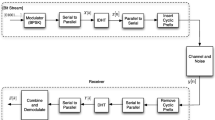Abstract
Single-carrier block transmission is an alternative scheme to orthogonal frequency-division multiplexing (OFDM) for wireless broadband communications. In this paper, a receiver is designed for single-carrier block transmission with cyclic prefix for mobile broadband communications. As the wireless transmission is over doubly selective channels, a basis expansion model is used to capture both the time- and frequency-selectivity of the channel and is parameterized for the receiver design. The receiver estimates the channel model coefficients in the time domain and uses these coefficients for equalization in the frequency domain. The channel estimation is assisted by time-domain pilot insertion. The structure of the frequency-domain channel matrix is exploited and a linear minimum mean-square error equalizer is used for the equalization. When the basis expansion model well matches the physical channel, simulation results show superior receiving performance of the proposed system compared with the OFDM system with a similar complexity.







Similar content being viewed by others
Explore related subjects
Discover the latest articles and news from researchers in related subjects, suggested using machine learning.References
Falconer, D., Ariyavisitakul, S. L., Benyamin-Seeyar, A., & Eidson, B. (2002). Frequency domain equalization for single-carrier broadband wireless systems. IEEE Communications Magazine, 40(4), 58–66.
Pancaldi, F., Vitetta, G. M., Kalbasi, R., Al-Dhahir, N., Uysal, M., & Mheidat, H. (2008). Single-carrier frequency domain equalization. IEEE Signal Processing Magazine, 25(5), 37–56.
Wang, Z., Ma, X., & Giannakis, G. B. (2004). OFDM or single-carrier block transmissions? IEEE Transactions on Communications, 52(3), 380–394.
Wang, N., & Blostein, S. D. (2005). Comparison of CP-based single carrier and OFDM with power allocation. IEEE Transactions on Communications, 53(3), 391–394.
Ohno, S. (2006). Performance of single-carrier block transmissions over multipath fading channels with linear equalization. IEEE Transactions on Signal Processing, 54(10), 3678–3687.
Liu, K., Kadous, T., & Sayeed, A. M. (2004). Orthogonal time-frequency signaling over doubly dispersive channels. IEEE Transactions on Information Theory, 50(11), 2583–2603.
Tsatsanis, M. K., & Giannakis, G. B. (1996). Modelling and equalization of rapidly fading channels. International Journal of Adaptive Control and Signal Processing, 10(3), 159–176.
Giannakis, G. B., & Tepedelenlioglu, C. (1998). Basis expansion models and diversity techniques for blind identification and equalization of time-varying channels. Proceedings of the IEEE, 86(10), 1969–1986.
Ahmed, S., Sellathurai, M., Lambotharan, S., & Chambers, J. A. (2006). Low-complexity iterative method of equalization for single carrier with cyclic prefix in doubly selective channels. IEEE Signal Processing Letters, 13(1), 5–8.
Schniter, P. (2004). Low-complexity equalization of OFDM in doubly selective channels. IEEE Transactions on Signal Processing, 52(4), 1002–1011.
Kambara, K., Nishimoto, H., Nishimura, T., Ohgane, T., & Ogawa, Y. (2008). Subblock processing in MMSE-FDE under fast fading environments. IEEE Journal on Selected Areas in Communications, 26(2), 359–365.
Guo, Q., Ping, L., & Huang, D. (2009). A low-complexity iterative channel estimation and detection technique for doubly selective channels. IEEE Transactions on Wireless Communications, 8(8), 4340–4349.
Ahn, S.-K., & Yang, K. (2013). A novel subblock-based frequency-domain equalizer over doubly-selective channels. IEEE Communications Letters, 17(8), 1517–1520.
Ohno, S., & Giannakis, G. B. (2002). Optimal training and redundant precoding for block transmissions with application to wireless OFDM. IEEE Transactions on Communications, 50(12), 2113–2123.
Minn, H., & Al-Dhahir, N. (2006). Optimal training signals for MIMO OFDM channel estimation. IEEE Transactions on Wireless Communications, 5(5), 1158–1168.
Dong, M., Tong, L., & Sadler, B. M. (2004). Optimal insertion of pilot symbols for transmissions over time-varying flat fading channels. IEEE Transactions on Signal Processing, 52(5), 1403–1418.
Barhumi, I., Leus, G., & Moonen, M. (2003). Optimal training design for MIMO OFDM systems in mobile wireless channels. IEEE Transactions on Signal Processing, 51(6), 1615–1624.
Ma, X., Giannakis, G. B., & Ohno, S. (2003). Optimal training for block transmissions over doubly selective wireless fading channels. IEEE Transactions on Signal Processing, 51(5), 1351–1366.
Kannu, A. P., & Schniter, P. (2008). Design and analysis of MMSE pilot-aided cyclic-prefixed block transmissions for doubly selective channels. IEEE Transactions on Signal Processing, 56(3), 1148–1160.
Ghogho, M., Whitworth, T., Swami, A., & McLernon, D. (2009). Full-rank and rank-deficient precoding schemes for single-carrier block transmissions. IEEE Transactions on Signal Processing, 57(11), 4433–4442.
Proakis, J. G., & Salehi, M. (2008). Digital communications (5th ed). NY: McGraw-Hill.
Kühn, V. (2006). Wireless communications over MIMO channels. London: Wiley.
Jakes, W. C. (1994). Microwave mobile communications (2nd ed.). New York: Wiley-Interscience.
Author information
Authors and Affiliations
Corresponding author
Rights and permissions
About this article
Cite this article
Dong, L. Receiver Design for Single-Carrier Block Transmission Over Doubly Selective Channels. Wireless Pers Commun 77, 1833–1845 (2014). https://doi.org/10.1007/s11277-014-1611-8
Published:
Issue Date:
DOI: https://doi.org/10.1007/s11277-014-1611-8




